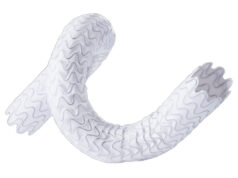
A small, randomised trial conducted in a UK dialysis unit has found that ultrasound guidance can improve cannulation accuracy—and this improvement may be most profound in arteriovenous (AV) fistulas that are more difficult to cannulate.
These findings, which were presented at the 12th Congress of the Vascular Access Society (VAS; 6–9 April 2021, online), also showed that cannulations conducted with ultrasound guidance took about 60 seconds longer, on average, than those conducted without, although this time difference could be offset once nursing staff became more experienced in using ultrasound machines.
The trial involved 36 patients with AV fistulas categorised as either amber, red or black based on estimations of how difficult they would be to cannulate, with amber being the easiest of these three groupings, and black being the most challenging. In a breakdown of these three categories, the red group was identified as having the most improved cannulation accuracy when using ultrasound guidance compared to the control group, in which ultrasound was not used.
George Smith, senior lecturer and consultant in vascular surgery at Hull York Medical School (York, UK), and the study’s presenting author, said: “It seems that ultrasound guidance is potentially most helpful in fistulas that are more difficult to needle.
“You would expect, therefore, that the black fistulas group would actually hold the greatest results, but I think we can explain that with the fact that these cannulations were performed solely by the six most experienced cannulators we have at the clinic, so the standard of cannulation for those procedures in both groups was of the absolute highest degree.”
The small-scale, randomised, mixed methods trial was conducted after Smith observed the vascular access clinic he was working in had received several referrals from dialysis units for AV fistulas that were proving difficult to needle. Smith and colleagues identified that the major difference between the two was that assessments in the access clinic were being conducted using ultrasound machines, which can produce clear and detailed images of where a fistula is, and what it looks like, while the dialysis unit nurses were simply palpating and trying to visualise fistulas through the skin.
Smith also stated that the fact that there is “very good evidence” ultrasound guidance can improve accuracy and result in fewer complications when used in other types of cannulations—such as central venous cannulations and arterial line insertions—led the team to believe there may be “significant advantages” to using ultrasound in AV fistulas as well.
Prior to the trial, the researchers identified that a lack of training or experience in using ultrasound machines among the dialysis unit’s nursing staff may prove to be an issue in the study, and therefore held a number of theoretical and practical sessions on how to operate these machines effectively—as well as giving each member of staff at least four weeks of supervised training from an ultrasound-qualified clinician—before the trial began.
Smith said the team was mainly concerned with needle accuracy in terms of outcomes, with this being measured by the number of needle passes and skin punctures required to cannulate. Any cannulation that required more than two needle passes or skin punctures, including withdrawals or readvancements, was considered inaccurate.
The mixed methods trial also assessed the mean time taken to successfully complete a cannulation, patient discomfort and anxiety, and difficulty experienced by the clinician in cannulating—both measured via visual analogue scales and questionnaires—and any complications observed during the procedures, including bleeding infiltrations or haematoma around the fistula, and thrombosis within the blood vessel or needle.
At the trial’s start date, there were 185 patients with AV fistulas in the dialysis unit, with 148 of these considered to be at the green level on the access clinic’s traffic light system for determining difficulty. With these being seen as the easiest to needle for, Smith stated that they were assessed as being the least likely to benefit from ultrasound-guided cannulation and were therefore excluded from the trial—leaving a total of 37 eligible patients, of which 32 chose to participate.
Some 17 of these patients’ fistulas were brachiocephalic, while 11 were radiocephalic and four were basilic vein transpositions. These 32 patients were assigned to either the ultrasound-guided cannulation group, or the control group, which featured standard cannulation using only palpation and visualisation through the skin. Each patient received 12 dialysis sessions over the course of the one-month trial period, resulting in a total of 170 ultrasound-guided cannulations and 176 non-ultrasound cannulations for the researchers to assess. Smith explained that the uneven number of total procedures was due to one patient withdrawing and a further three being transferred to other units during the trial.
The trial’s results found a “significant reduction” in the additional number of needle passes required to cannulate, according to Smith, with 72 additional passes and 10 skin punctures in the ultrasound group compared to 99 and 25 respectively in the control group—suggesting ultrasound guidance was the more accurate of the two approaches.
The mean time taken to complete cannulations was 241 seconds in the ultrasound group compared to 181 seconds in the control group, which Smith said was also “statistically significant”. The study found no significant difference between the discomfort or anxiety experienced by the patients, the difficulty experienced by the clinicians when cannulating, or the rate or nature of the observed complications, between the two groups.
“In terms of assessing these findings, there was obviously a learning curve for some of the staff, and we have also got a relatively small number of patients—we thought we may see differences in the number of complications between the two groups, but I suspect that would only be picked up in a much larger trial,” Smith added.
“And, potentially, in a longer trial in the future, we may see some additional benefits in that nurses may be able to identify additional cannulation sites that are not immediately obvious, reducing the risk of poor-quality area cannulation in the process.”










